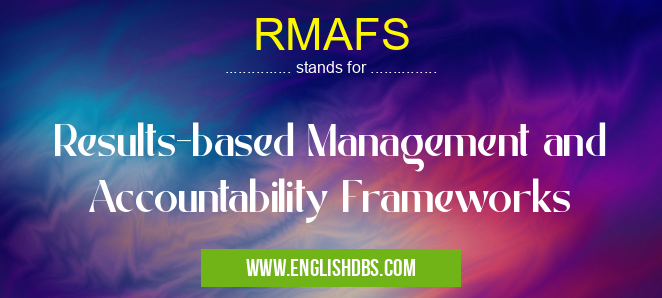What does RMAFS mean in MANAGEMENT
RMAFS stands for Results-based Management and Accountability Frameworks. It's a comprehensive framework that assists organizations in measuring and managing their performance effectively. RMAFS focuses on achieving specific goals and objectives through structured processes, monitoring, and evaluation.

RMAFS meaning in Management in Business
RMAFS mostly used in an acronym Management in Category Business that means Results-based Management and Accountability Frameworks
Shorthand: RMAFS,
Full Form: Results-based Management and Accountability Frameworks
For more information of "Results-based Management and Accountability Frameworks", see the section below.
» Business » Management
Key Features of RMAFS
- Focus on Results: RMAFS emphasizes the importance of achieving specific outcomes and results. It aligns organizational activities with strategic objectives, ensuring that resources are allocated efficiently.
- Accountability Mechanisms: RMAFS establishes clear accountability mechanisms, assigning responsibility for performance outcomes to specific individuals or teams. This fosters a culture of ownership and responsibility.
- Performance Measurement: RMAFS involves establishing metrics and performance indicators that measure progress toward goals. Regular monitoring and evaluation allow for timely adjustments and improvements.
- Continuous Improvement: RMAFS promotes continuous improvement by facilitating feedback loops and learning from performance data. This helps organizations identify areas for improvement and enhance their effectiveness over time.
Benefits of Using RMAFS
- Improved Performance: RMAFS provides a structured approach to performance management, leading to better decision-making and improved outcomes.
- Enhanced Accountability: Clear accountability mechanisms ensure that individuals and teams are responsible for achieving desired results.
- Effective Resource Allocation: RMAFS aligns resources with strategic priorities, optimizing their utilization and maximizing impact.
- Continuous Learning: Regular feedback and evaluation foster a culture of continuous learning and improvement, enabling organizations to adapt and thrive.
Essential Questions and Answers on Results-based Management and Accountability Frameworks in "BUSINESS»MANAGEMENT"
What are Results-based Management and Accountability Frameworks (RMAFs)?
RMAFs are frameworks that provide a structured approach to managing and accounting for the performance of government programs and initiatives. They establish clear performance goals, objectives, and indicators, and outlines the processes for monitoring, evaluating, and reporting on progress.
What are the key components of an RMAF?
Key components of an RMAF include:
- Performance Goals: High-level, long-term outcomes that the program or initiative aims to achieve.
- Objectives: Specific, measurable, achievable, relevant, and time-bound targets that contribute to the achievement of the performance goals.
- Indicators: Data or measures used to track progress towards the objectives.
- Monitoring and Evaluation Plan: Describes the processes for collecting, analyzing, and using data to assess and report on performance.
- Accountability Framework: Outlines roles and responsibilities for performance management, including reporting, oversight, and decision-making.
What are the benefits of using RMAFs?
RMAFs offer several benefits, including:
- Improved performance management and accountability
- Enhanced transparency and communication
- Data-driven decision-making
- Increased stakeholder engagement
- Efficient use of resources
Final Words: RMAFS serves as a valuable framework for organizations seeking to enhance their performance management practices. By focusing on results, accountability, performance measurement, and continuous improvement, RMAFS empowers organizations to achieve their strategic goals effectively and efficiently.
